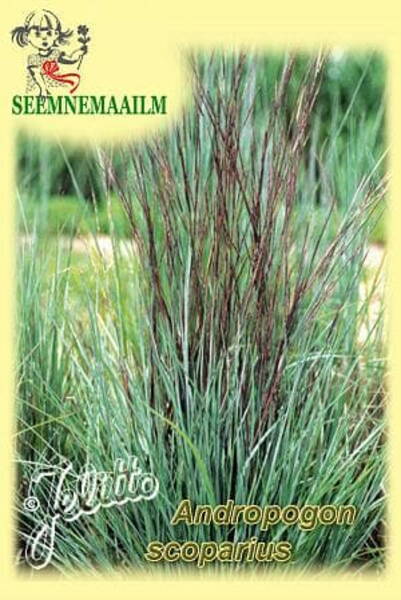Your shopping cart is empty!
Little Bluestem (Blue-Stem Grass)
Blue-Stem Grass - Andropogon scoparius (Schizachyrium).
Perennial from the Poaceae family.
Changeable and beautiful fall colours for natural landscaping.
Origin: eastern North America (prairies, grasslands).
Flowering plant height: 120 cm.
Distance between plants: 40 cm.
Main colour: pink-salmon.
Natural flowering period: August – October.
Soil requirements: dry, well-drained, average fertility. The plant does not require special care.
Winter hardiness zones: Z3 – Z9.
1,0 g = 800 seeds.
Location: in the shade, it grows weakly and falls apart, so it is better to plant it in the sun. Not picky about soil fertility. But in order to quickly get an ornamental bush, it is better to plant it in fertile soil. Very winter hardy.
Propagation: easily propagated by seeds or by dividing tussocks in spring or early summer. Crops are kept at +20 °C, germination is slow. When propagating by seeds, you will have to wait 2-3 years until the plant reaches its full decorative effect.
Uses: this vigorous, long-leafed grass is very effective in gardens due to its large size and erect tussock shape. It is ideal for green screens in natural and landscape gardens. The autumn colour of the leaves is also spectacular.
From history: North American Indians once used the dried stems of this plant to insulate moccasins in the winter.
Perennial from the Poaceae family.
Changeable and beautiful fall colours for natural landscaping.
Origin: eastern North America (prairies, grasslands).
Flowering plant height: 120 cm.
Distance between plants: 40 cm.
Main colour: pink-salmon.
Natural flowering period: August – October.
Soil requirements: dry, well-drained, average fertility. The plant does not require special care.
Winter hardiness zones: Z3 – Z9.
1,0 g = 800 seeds.
Location: in the shade, it grows weakly and falls apart, so it is better to plant it in the sun. Not picky about soil fertility. But in order to quickly get an ornamental bush, it is better to plant it in fertile soil. Very winter hardy.
Propagation: easily propagated by seeds or by dividing tussocks in spring or early summer. Crops are kept at +20 °C, germination is slow. When propagating by seeds, you will have to wait 2-3 years until the plant reaches its full decorative effect.
Uses: this vigorous, long-leafed grass is very effective in gardens due to its large size and erect tussock shape. It is ideal for green screens in natural and landscape gardens. The autumn colour of the leaves is also spectacular.
From history: North American Indians once used the dried stems of this plant to insulate moccasins in the winter.












